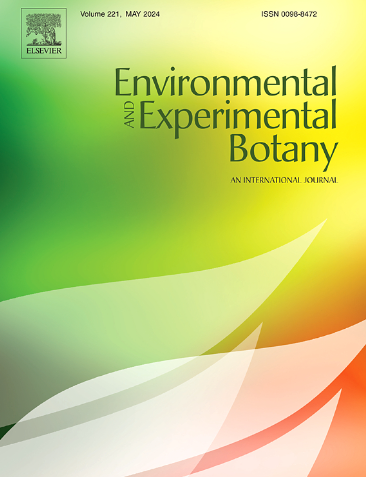生理、转录组学和代谢组学分析揭示了江蓠对长期盐胁迫的适应机制
IF 4.7
2区 生物学
Q2 ENVIRONMENTAL SCIENCES
引用次数: 0
摘要
盐度是影响大型藻类组成、生长和繁殖的重要生态因子。刘氏江蓠(Gracilaria tenuistipitata变种)是中国南方重要栽培种,具有重要的经济和生态意义。它生活在潮间带、河口、咸淡池塘和泻湖中,最佳生长盐度范围为15-30 psu,长期耐受盐度为5-75 psu。尽管G. tenuistipitata显示出对广泛盐度的长期适应性,但其耐盐性的分子机制仍然知之甚少。为了探索这些机制,我们研究了G. tenuistipitata对不同盐度(5 - 70 psu)的生理反应,并分析了其在5 psu (S5)、60 psu (S60)和30 psu (S30,对照)下的转录组学和代谢组学特征。生理数据表明,盐度对生长、光合作用和总可溶性蛋白含量有显著影响。转录组测序共产生85,894个unigenes,其中42,503个成功注释。对比分析显示,S30组和S5组有1480个差异表达基因(deg)(759个表达上调;721个下调)和2451个deg在S30组和S60组(1255个上调;1196表达下调)。氮代谢、甜菜素生物合成、氨基酸生物合成和类胡萝卜素生物合成途径在S5中显著富集。在S60中,ABC转运蛋白通路富集相对显著。共检测到25种代谢物,其中S5与S30的代谢物谱更为相似。盐度变化对黄颡鱼能量代谢、光合作用和抗氧化系统的调控有显著影响。总体而言,黄貂鱼对低盐环境表现出更强的耐受性。这些发现为了解黄颡鱼适应盐度的分子基础提供了有价值的见解,有助于更好地了解其生态和经济潜力。本文章由计算机程序翻译,如有差异,请以英文原文为准。
Physiological, transcriptomic, and metabolomic analyses reveal the adaptation mechanism of Gracilaria tenuistipitata var. liui under long-term salt stress
Salinity is a critical ecological factor influencing the composition, growth, and reproduction of macroalgae. Gracilaria tenuistipitata var. liui is a key cultivated species of Gracilaria in southern China, with both economic and ecological significance. It inhabits in intertidal zones, estuaries, brackish ponds, and lagoons, with an optimal growth salinity range of 15–30 psu and long-term tolerance to salinities of 5–75 psu. Although G. tenuistipitata demonstrates long-term adaptability to a broad range of salinities, the molecular mechanisms underlying its salinity tolerance remain poorly understood.To explore these mechanisms, we investigated the physiological responses of G. tenuistipitata to varying salinities (5–70 psu) and analyzed its transcriptomic and metabolomic profiles at salinities of 5 psu (S5), 60 psu (S60), and 30 psu (S30, control). Physiological data indicated that growth, photosynthesis, and total soluble protein content were significantly affected by salinity levels. Transcriptome sequencing generated a total of 85,894 unigenes, with 42,503 successfully annotated. Comparative analysis revealed 1480 differentially expressed genes (DEGs) in the S30 vs S5 group (759 upregulated; 721 downregulated) and 2451 DEGs in the S30 vs S60 group (1255 upregulated; 1196 downregulated). Nitrogen metabolism, Betalain biosynthesis, Biosynthesis of amino acids and Carotenoid biosynthesis pathways were significantly enriched in the S5. In the S60, ABC transporters pathway enrichment was relatively significant. A total of 25 metabolites were detected, the metabolite profiles of S5 were more similar to those of S30. Salinity variation had a significant impact on the regulation of energy metabolism, photosynthesis, and antioxidant systems in G. tenuistipitata. Overall, G. tenuistipitata exhibited stronger tolerance to hypo-saline conditions. These findings provide valuable insights into the molecular basis of salinity adaptation in G. tenuistipitata, contributing to a better understanding of its ecological and economic potential.
求助全文
通过发布文献求助,成功后即可免费获取论文全文。
去求助
来源期刊

Environmental and Experimental Botany
环境科学-环境科学
CiteScore
9.30
自引率
5.30%
发文量
342
审稿时长
26 days
期刊介绍:
Environmental and Experimental Botany (EEB) publishes research papers on the physical, chemical, biological, molecular mechanisms and processes involved in the responses of plants to their environment.
In addition to research papers, the journal includes review articles. Submission is in agreement with the Editors-in-Chief.
The Journal also publishes special issues which are built by invited guest editors and are related to the main themes of EEB.
The areas covered by the Journal include:
(1) Responses of plants to heavy metals and pollutants
(2) Plant/water interactions (salinity, drought, flooding)
(3) Responses of plants to radiations ranging from UV-B to infrared
(4) Plant/atmosphere relations (ozone, CO2 , temperature)
(5) Global change impacts on plant ecophysiology
(6) Biotic interactions involving environmental factors.
 求助内容:
求助内容: 应助结果提醒方式:
应助结果提醒方式:


